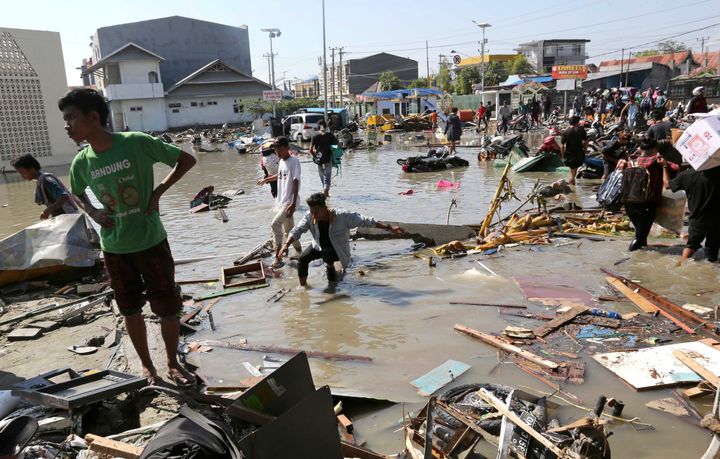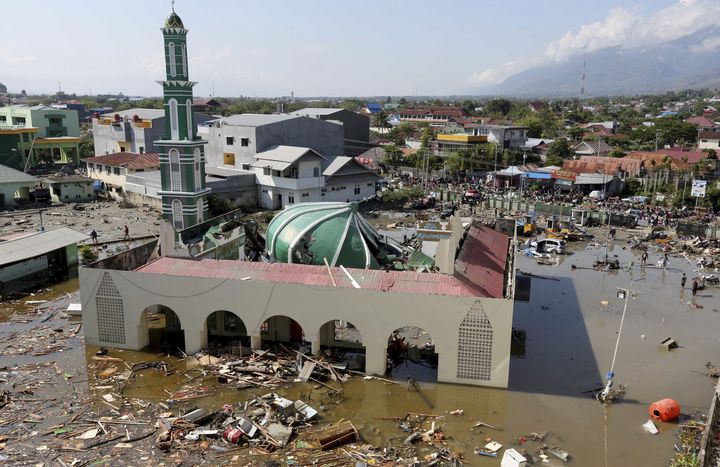The death toll from an earthquake and tsunami that devastated part of the island of Sulawesi has climbed to 832, with officials saying it could reach into the thousands.
More than 150 aftershocks have been felt following the 7.4-magnitude earthquake which sparked a devastating tsunami.
The waves hit Sulawesi on Friday, causing thousands of homes, hotels, shopping malls and several mosques to collapse.
The actual death toll may not be known for some time as rescuers struggle to reach outlying communities cut off from communications and help.
Authorities are bracing for much worse as reports filter in from outlying areas, in particular, Donggala, a region of 300,000 people north of Palu and close to the epicentre of the quake, and two other districts.
Vice President Jusuf Kalla said the toll could rise into the thousands.
President Joko Widodo visited a housing complex flattened when the quake liquefied the soil it stood on, and called for patience.
“I know there are many problems that need to be solved in a short time, including communications,” he said.
Scores of residents shouted “we’re hungry, we need food” as soldiers distributed rations from a truck in one neighbourhood, while elsewhere television showed pictures of people making off with clothes and other items from a wrecked mall.
Internal Affairs Minister Tjahjo Kumolo, asked about reports of sporadic looting, said he had ordered authorities to help people get food and drink and businesses would be compensated.
Sutopo Purwo Nugroho, the spokesman of the national disaster mitigation agency, told a news conference on Sunday that 821 of those killed were in the city of Palu. He said another 11 people were killed in the town of Donggala.
He said access to Donggala, as well as the towns of Sigi and Boutong, is still limited and there are no comprehensive reports from those areas.
He said: “The death is believed to be still increasing since many bodies were still under the wreckage while many have not able to be reached.”

People could still be heard calling out from the eight-storey Roa-Roa Hotel which collapsed as the disasters swept through the city, said Muhammad Syaugi, the head of Indonesia’s search and rescue agency.
“I can still hear the voices of the survivors screaming for help while inspecting the compound,” he told local online news portal Detik.com, adding there could be 50 people trapped inside.
Aid and supplies are being sent in via military and commercial aircraft, including helicopters, to reach badly affected areas.

TV footage showed images of destroyed houses in Donggala and areas that were once land now inundated with water. Aerial video also showed the battered coastline surrounding Palu.
Looters were stealing from a badly damaged shopping centre in Palu that was not being guarded. They did not appear to be concerned about their safety, despite ongoing aftershocks and the structure’s questionable stability.
Residents were also seen returning to their destroyed homes, picking through waterlogged belongings, trying to salvage anything they could find.

Disaster agency spokesman Sutopo Purwo Nugroho said “tens to hundreds” of people were taking part in a beach festival in Palu when the tsunami struck at dusk on Friday.
Hundreds of people were injured and hospitals damaged by the quake were overwhelmed.
Indonesia, which sits on the seismically active Pacific Ring of Fire, is all too familiar with deadly earthquakes and tsunamis. In 2004, a quake off Sumatra island triggered a tsunami across the Indian Ocean, killing 226,000 people in 13 countries, including more than 120,000 in Indonesia.
Questions are being asked why warning systems set up after that disaster appear to have failed on Friday. Nugroho, bemoaning a fall in funding, said no tsunami buoys, one type of instrument used to detect the waves, in Indonesia had been operating since 2012.
The meteorological and geophysics agency BMKG issued a tsunami warning after the quake but lifted it 34 minutes later, drawing criticism it had been too hasty. But officials estimated the waves had hit while the warning was in force.
